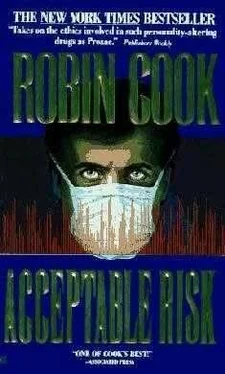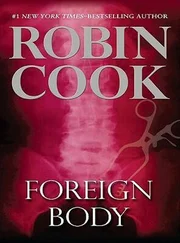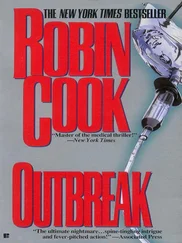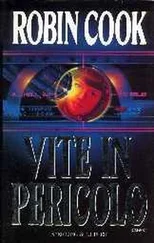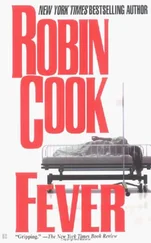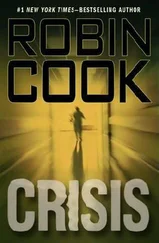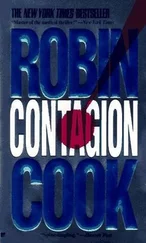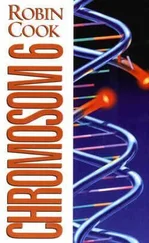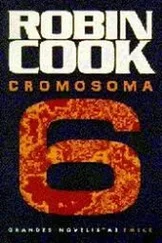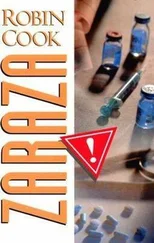Robin Cook - Acceptable Risk
Здесь есть возможность читать онлайн «Robin Cook - Acceptable Risk» весь текст электронной книги совершенно бесплатно (целиком полную версию без сокращений). В некоторых случаях можно слушать аудио, скачать через торрент в формате fb2 и присутствует краткое содержание. Жанр: Триллер, на английском языке. Описание произведения, (предисловие) а так же отзывы посетителей доступны на портале библиотеки ЛибКат.
- Название:Acceptable Risk
- Автор:
- Жанр:
- Год:неизвестен
- ISBN:нет данных
- Рейтинг книги:4 / 5. Голосов: 1
-
Избранное:Добавить в избранное
- Отзывы:
-
Ваша оценка:
- 80
- 1
- 2
- 3
- 4
- 5
Acceptable Risk: краткое содержание, описание и аннотация
Предлагаем к чтению аннотацию, описание, краткое содержание или предисловие (зависит от того, что написал сам автор книги «Acceptable Risk»). Если вы не нашли необходимую информацию о книге — напишите в комментариях, мы постараемся отыскать её.
Acceptable Risk — читать онлайн бесплатно полную книгу (весь текст) целиком
Ниже представлен текст книги, разбитый по страницам. Система сохранения места последней прочитанной страницы, позволяет с удобством читать онлайн бесплатно книгу «Acceptable Risk», без необходимости каждый раз заново искать на чём Вы остановились. Поставьте закладку, и сможете в любой момент перейти на страницу, на которой закончили чтение.
Интервал:
Закладка:
At that point Edward’s true forte, synthetic organic chemistry, came to bear. In a marathon effort from early Thursday to late Thursday night, Edward ingeniously figured out a process to formulate the hypothetical drug from standard, available reagents. By early Friday morning he produced a vialful of the new drug.
“What do you think?” Edward asked Eleanor as the two of them gazed at the vial. They were both exhausted, but neither had any intention of sleeping.
“I think you’ve accomplished an amazing feat of chemical virtuosity,” Eleanor said sincerely.
“I wasn’t looking for a compliment,” Edward said. He yawned. “I’m interested to know what you think we should do first.”
“I’m the conservative member of this team,” Eleanor said. “I’d say let’s get an idea of toxicity.”
“Let’s do it,” Edward said. He heaved himself to his feet and lent Eleanor a hand. Together they went back to work.
Empowered by their accomplishments and impatient for immediate results, they forgot scientific protocol. As they had done with the natural alkaloid, they dispensed with controlled, careful studies to get a rapid, general data to give them an idea of the drug’s potential.
The first thing they did was add varying concentrations of the drug to various types of tissue cultures, including kidney and nerve cells. With even relatively large doses they were happy to see no effect. They put the cultures in an incubator so that they could periodically access them.
Next they prepared a ganglion preparation from Aplasia fasciata by inserting tiny electrodes into spontaneously firing nerve cells. Connecting the electrodes to an amplifier, they created an image of the cells’ activity on a cathode ray tube. Slowly they added their drug to the perfusing fluid. By watching the neuronal responses, they determined that the drug was indeed bioactive although it didn’t depress or increase the spontaneous activity. Instead the drug appeared to stabilize the rhythm.
With mounting excitement, since everything they did yielded positive results, Eleanor began feeding the new drug to a new batch of stressed rats while Edward added the new drug to a fresh synaptosome preparation. Eleanor was the first to get results. She was quickly convinced the modified drug had even more calming effect on the rats than the unaltered alkaloid.
It took Edward a little longer to get his results. He found that the new drug affected the levels of all three neurotransmitters, but not equally. Serotonin was affected more than norepinephrine, which was affected more than dopamine. What he didn't expect was that the drug seemed to form a loose covalent bond with both glutamate and gamma-aminobutyric acid, two of the major inhibitory agents in the brain.
“This is all fantastic!” Edward exclaimed. He picked up the papers from his desk that recorded all their findings and allowed them to rain down like massive sheets of confetti. “This data suggests that the potential of the drug is monumental. I’m willing to bet it’s both an antidepressant and an anxiolytic, and as such it could revolutionize the field of psychopharmacology. It might even eventually be compared with the discovery of penicillin.”
“We still have the worry about it being hallucinogenic,” Eleanor said.
“I sincerely doubt it,” Edward said. “Not after removing that LSD-like side chain. But I agree we have to be sure.”
“Let’s check the tissue cultures,” Eleanor said. She knew Edward would want to take the drug. It was the only way to determine if it was hallucinogenic.
They retrieved their tissue cultures from the incubator and examined them under a low-power microscope. One after another they appeared healthy. There was no sign of cellular damage from the new drug, even those subjected to high doses.
“There doesn’t seem to be any toxicity at all,” Edward said with glee.
“I wouldn’t have believed it if I hadn’t seen it,” Eleanor said.
They went back to Edward’s bench area and made up several solutions of increasing strength. The starting point was a concentration that yielded a dose approximating the dosage of the unmodified alkaloid that Stanton had received. Edward was the first to try it, and when nothing happened, Eleanor took it. Again nothing happened.
Encouraged by these negative results, Edward and Eleanor gradually increased their dosages up to a full milligram, knowing that LSD was psychedelic at 0.05 milligrams.
“Well?” Edward questioned a half hour later.
“No hallucinogenic effect as far as I can tell,” Eleanor said.
“But there is an effect,” Edward said.
“Most definitely,” Eleanor said. “I’d have to describe it as calm contentment. Whatever it is, I like it.”
“I also feel as if my mind is particularly sharp,” Edward said. “It has to be drug-related because twenty minutes ago I was a basket case, thinking my ability to concentrate was nil. Now I’m energized as if I’d had a night’s rest.”
“I have a sense my long-term memory has been awakened from a slumber,” Eleanor said. “Suddenly I remember my home phone number when I was a child of six. It was the year my family moved to the West Coast.”
“What about your senses?” Edward asked. “Mine seem particularly acute, especially my sense of smell.”
“I wouldn’t have thought of it until you mentioned it,” Eleanor said. She put her head back and sniffed the air. “I never realized the lab was such a cacophony of odors.”
“There’s something else I’m feeling that I wouldn’t have even been sensitive to if I hadn’t taken a course of Prozac,” Edward said. “I feel socially assertive, like I could walk into a group of people and do whatever I wanted. The difference is that it took three months of Prozac before I felt that way.”
“I can’t say I feel anything like that,” Eleanor said. “But I can say my mouth is a little dry. Is yours?”
“Perhaps,” Edward admitted. Then he looked directly into Eleanor’s deep blue eyes. “Your pupils also might be a bit dilated. If they are, it must be the scopolamine side chain we couldn’t totally eliminate. Check your near vision.”
Eleanor picked up a reagent bottle and read the tiny print on the label. “No problem,” she said.
“Anything else?” Edward said. “Any trouble with your circulation or breathing?”
“Everything is fine,” Eleanor said.
“Excuse me,” a voice called.
Eleanor and Edward turned to see one of the second-year doctorate students had approached them. “I need some help,” she said. Her name was Nadine Foch. She was from Paris. “The NMR is not functioning.”
“Perhaps it would be best to talk to Ralph,” Edward said. He smiled warmly. “I’d like to help, but I’m rather involved at the moment. Besides, Ralph knows the machine better than I, particularly from a technical point of view.”
Nadine thanked them and went to find Ralph.
“That was rather civil of you,” Eleanor said.
“I feel rather civil,” Edward said. “Besides, she’s a nice person.”
“Perhaps this is a good time for you to resume your normal activities,” Eleanor said. “We’ve made fantastic progress.”
“It’s only a harbinger of what’s to come,” Edward said. “It’s good of you to worry about my teaching and supervisory responsibilities, but I assure you that they can slide for several weeks without causing anybody irreparable damage. I’m not about to forfeit any of this excitement with this new drug. Meanwhile I want you to start computerized molecular modeling to create a family of compounds from our new drug by substituting side chains.”
While Eleanor went off to work at her computer terminal, Edward walked back to his desk and picked up the phone. He called Stanton Lewis.
Читать дальшеИнтервал:
Закладка:
Похожие книги на «Acceptable Risk»
Представляем Вашему вниманию похожие книги на «Acceptable Risk» списком для выбора. Мы отобрали схожую по названию и смыслу литературу в надежде предоставить читателям больше вариантов отыскать новые, интересные, ещё непрочитанные произведения.
Обсуждение, отзывы о книге «Acceptable Risk» и просто собственные мнения читателей. Оставьте ваши комментарии, напишите, что Вы думаете о произведении, его смысле или главных героях. Укажите что конкретно понравилось, а что нет, и почему Вы так считаете.
